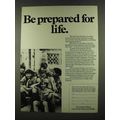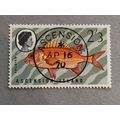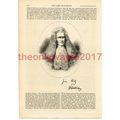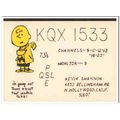London - Selfridges, Oxford Street - super 1960s Dixon postcard
- Condition : Used
- Dispatch : 2 Days
- Brand : None
- ID# : 130101329
- Quantity : 1 item
- Views : 3146
- Location : United Kingdom

- Seller : justthebook (+1704)
- Barcode : None
- Start : Wed 09 Jul 2014 17:00:56 (BST)
- Close : Run Until Sold
- Remain : Run Until Sold
More Listings from This Seller view all
Seller's Description
- Postcard
- Picture / Image: Oxford Street - shows Selfridges, red buses etc., London
- Publisher: J Arthur Dixon (Lon. 2925)
- Postally used: no
- Stamp: n/a
- Postmark(s): n/a
- Sent to: n/a
- Notes / condition:
Please ask if you need any other information and I will do the best I can to answer.
Image may be low res for illustrative purposes - if you need a higher definition image then please contact me and I may be able to send one.
------------------------------------------------
Postage & Packing:
Postage and packing charge should be showing for your location (contact if not sure).
No additional charges for more than one postcard. You can buy as many postcards from me as you like and you will just pay the fee above once. (If buying postcards with other things such as books, please contact or wait for invoice before paying).
Payment Methods:
UK - PayPal, Cheque (from UK bank) or postal order
Outside UK: PayPal ONLY (unless otherwise stated) please. NO non-UK currency checks or money orders (sorry).
NOTE: All postcards are sent in brand new stiffened envelopes which I have bought for the task. These are specially made to protect postcards and you may be able to re-use them. In addition there are other costs to sending so the above charge is not just for the stamp!
I will give a full refund if you are not fully satisfied with the postcard.
----------------------------------------------
Text from the free encyclopedia WIKIPEDIA may appear below to give a little background information (internal links may not work) :
*************
Selfridges, Oxford Street is a Grade II listed retail premises, located in Oxford Street, London, England. It was designed by Daniel Burnham for Harry Gordon Selfridge, and opened in 1909.[1] Still the headquarters of Selfridge & Co. department stores, with 540,000 square feet (50,000 m2) of selling space,[2] the store is the second largest retail premises in the UK,[1] half as big as the biggest department store in Europe, Harrods.[2] It was named the world's best department store in 2010,[3] and again in 2012.[4]
In 1906, Harry Gordon Selfridge travelled to England on holiday with his wife, Rose. Unimpressed with the quality of existing British retaillers, he noticed that the large stores in London had not adopted the latest selling ideas that were being used in the United States. Selfridge decided to invest £400,000 in building his own department store in what was then the unfashionable western end of Oxford Street, by slowly buying up a series of Georgian architecture buildings which were on the desired block defined by the surrounding four streets: Somerset, Wigmore, Orchard and Duke.[5]
The building was designed by American architect Daniel Burnham, who also crafted Marshall Field's main store in his home town of Chicago, and the Flatiron Building in New York. The building was an early example in the UK of the use of a steel frame, five stories high with three basement levels and a roof terrace, originally laid out to accommodate 100 departments.[6]
American-trained Swedish structural engineer Sven Bylander was engaged to design the steel frame structure. As the building was one of the early examples of steel frame in the UK, Bylander had to first agree appropriate building regulations with the London County Council, requiring amendments to the London Building Act 1844.[7] Using as a basis the regulations which covered the similarly-designed London docklands warehouses, Bylander then agreed changes which enabled greater spans within lesser beam dimensions due to the use of steel over stone.[7] Bylander designed the entire supporting structure which was approved by the LCC in 1907,[7] with a steel frame based on blue brick pile foundations, supporting a steel frame which holds all of the internal walls and the concrete floors.[7] Bylander designed in additional supported internal walls, as LCC would not approve store areas above 450,000 cubic foot (13,000 m3) due to the then approved fire safety regulations, many of which were removed 20 years later in light of new legislation.[7] Bylander submitted a 13 page fully illustrated account of the design of the building to Concrete and Constructional Engineering, which was published in 1909.[7] The work of Burnham and Bylander with LCC led to the passing of the LCC (General Powers) Act 1909, also called the Steel Frame Act, which gave the council the power to regulate the construction of reinforced concrete structures.[7]
American architect Francis Swales, who trained at the École Nationale Supérieure des Beaux-Arts in Paris, was briefed to design the frontispiece. Aided by British architects R. Frank Atkinson and Thomas Smith Tait,[6][8] the final design was highly influenced by John Burnet's 1904 extension to the British Museum.[5] The steel supporting columns are hidden behind Ionic columns, to create a facade which present a visually uniform, classical, Beaux-Arts appearance.[9] The distinctive polychrome sculpture above the Oxford Street entrance is the work of British sculptor Gilbert Bayes. The final frontage, through use of cast iron window frames to a maximum size of 19 feet 4 inches (5.89 m) by 12 feet 0 inches (3.66 m), means that both the Oxford Street and Duke Street frontages are made up of more glass than stone or iron works.[7]
Opened on 15 March 1909,[1] the store was built in phases. The first phase consisted of the nine-and-a-half bays closest to the Duke Street corner,[10] a site of 250 feet (76 m) wide on Oxford Street by 175 feet (53 m) along Duke Street.[7] The floor heights averaged 15 feet (4.6 m), and the initial structure contained nine passenger lifts, two service lifts and six staircases.[7]
The main entrance and all of the bays to its left were added some 18 years after the store first opened, using a modified construction system.[9] The complete building opened fully in 1928, and resultantly through the use of supporting spandrel steel panels, the scale of the glass panes within the main entrance could be greatly enlarged.[5]
A scheme to erect a massive tower above the store post-World War I was never carried out. Harry Selfridge also proposed a subway link to Bond Street station, and renaming it ""Selfridges""; however, contemporary opposition quashed the idea.
The final design of the building completed in 1928, although classical in visible style and frontage, is thoroughly modern in its steel frame construction. In part due to new schools of architectural thought emerging apart from the classical schools, and in part due to the close proximity of World War I, the building is seen as the last of the great classical buildings undertaken within the UK. Although the UK was late in adopting modern architecture only from the 1930s onwards,[11] by the mid-20th century many architects looked at Selfridges as if it were pre-historic in design, accepted just because Harry Gordon Selfridge wanted to advetise his business with a confident display of classicism in stone.[5]
There are two levels of basement beneath the lower-ground shop floor: the ‘sub’ and the ‘sub-sub’. Combined, these descend 60 metres (200 ft) below street level.[5][12] These two areas are then split into two more areas: the dry sub and sub-sub, and their ""wet"" equivalents.[5][12] The wet area is beneath the original nine-and-a-half bays closest to the Duke Street corner of the 1909 building. The ""dry"" is under the rear of the building, known as the SWOD after the surrounding four streets - Somerset, Wigmore, Orchard and Duke – that once enclosed it.[5][12][13] During World War II after the entry of the United States into the conflict, from 1942 the dry sub-sub SWOD was used by the United States Army. The building had one of the only secure telex lines, was safe from bombing, and was close to the US Embassy on Grosvenor Square. Initially used by General Eisenhower, the commander of SHAEF, it later housed 50 soldiers from the 805th Signal Service Company of the US Army Signal Corps,[13] who installed a SIGSALY code-scrambling device connected to a similar terminal in the Pentagon building. The first conference took place on the 15 July 1943. Initial visitors included Prime Minister Winston Churchill, to enable secure communications with the President of the United States, although later extensions were installed to both 10 Downing Street and the Cabinet War Rooms.[14] Rumours persist of a tunnel built from Selfridges to the embassy so that personnel could move between the two in safety, with interrogation cells for prisoners hewn from the resultant uneven space available.[12]
While restoration work was carried in 2002,[9] the scaffold surround was used to carry the largest photographic artwork ever produced, 60 feet (18 m) tall by 900 feet (270 m) long and weighing two tons. Created by Sam Taylor-Wood, it showed a gathering of well-known pop and cultural figures of the time, including Sir Elton John.
At that time, women were beginning to enjoy the fruits of emancipation by wandering unescorted around London. A canny marketer, Selfridge promoted the radical notion of shopping for pleasure rather than necessity. The store was extensively promoted through paid advertising. The shop floors were structured so that goods could be made more accessible to customers. There were elegant restaurants with modest prices, a library, reading and writing rooms, special reception rooms for French, German, American and ""Colonial"" customers, a First Aid Room, and a Silence Room, with soft lights, deep chairs, and double-glazing, all intended to keep customers in the store as long as possible. Staff members were taught to be on hand to assist customers, but not too aggressively, and to sell the merchandise. Oliver Lyttleton observed that, when one called on Selfridge, he would have nothing on his desk except one's letter, smoothed and ironed.[15]
Selfridge also managed to obtain from the GPO the privilege of having the number ""1"" as its own phone number, so anybody had to just dial 1 to be connected to Selfridge's operators.
The roof terrace hosted terraced gardens, cafes, a mini golf course and an all-girl gun club. The roof, with its spectacular views across London, was a popular place for strolling after a shopping trip and was often used for fashion shows. As with much of central London during World War II, Selfridges suffered serious damage on a number of occasions during the 57 nights of the London Blitz from 7 September 1940, and in 1941 and 1944.[16] After the devastating bombing of the west end on 17/18 September 1940 by a combined force of 268 Heinkel 111 and Dornier Do 17 bombers[16] - after which the stores Art Deco lifts didn't work again until post-WW2, and the signature window was shattered[16][17] - Harry vowed never to open the rooftop gardens again,[18] and had the ground floor windows bricked-up.[16][17] The roof terrace reopened again for the first time since in July 2011, for a promotional event staged by Truvia as part of their UK launch.[19] Bompas & Parr designed a publicly accessible art-installation, consisting of a rowing lake which was dyed green, with 12 rowing boats and an accompanying bar.[18] In Summer 2012, Bompas & Parr designed an art installation themed as ""The Big British Tea Party"", which included a cake-themed 9-hole crazy golf course, accompanied by a Daylesford Organic sponsored tea house.[20]
The bomb on the 17 April 1941 only destroyed the beautiful Palm Court Restaurant, venue for the rich and famous.[16] However, at 11pm on 6 December 1944, a V-2 rocket hit the Red Lion pub on the corner of Duke Street and Barrett Street. A canteen in the SWOD was massively damaged, with eight American servicemen killed and 32 injured, as well as ten civilian deaths and seven injuries.[16] In the main building, ruptured water mains threatened SIGSALY, and while the Food Hall was the only department that did not need cleaning, Selfridges’ shop-front Christmas tree displays were blown into Oxford Street.[16][17] By 2010, only two of the four major pre-World War II Oxford Street retaillers - Selfridges and John Lewis - survive in retail, while Bourne & Hollingsworth (now remembered in the name of a bar in Fitzrovia), and Peter Robinson (acquired 1946 by Burton's), are no longer trading.[16] Selfridges are the only retailer still trading in the same building, which still bears the scars of war damage, while Lewis's have moved.[16] Bourne & Hollingsworth is now the Plaza Shopping Centre at No 120, while Peter Robinson is now Niketown at No 200-236.[16]
A Milne-Shaw seismograph was set up on the Selfridges' third floor in 1932, attached to one of the building's main stanchions, unaffected by traffic or shoppers. It recorded the Belgian earthquake of 11 June 1938 which was also felt in London. At the outbreak of war, the seismograph was moved from its original site near the Post Office to another part of the store. In 1947, the seismograph was given to the British Museum.
In 2002, Selfridges was awarded the London Tourism Award for visitors' favourite London store. Selfridges was named world's best department store in 2010,[3] and again in 2012.[4] It claims to contain the UK's largest beauty department,[13] and Europe's busiest doorway which siphons 250,000 people a week past the Louis Vuitton concession on to Oxford Street.[13]
type=printed postcards
theme=topographical: british
sub-theme=england
county/ country=london
number of items=single
period=1945 - present
postage condition=unposted
Listing Information
| Listing Type | Gallery Listing |
| Listing ID# | 130101329 |
| Start Time | Wed 09 Jul 2014 17:00:56 (BST) |
| Close Time | Run Until Sold |
| Starting Bid | Fixed Price (no bidding) |
| Item Condition | Used |
| Bids | 0 |
| Views | 3146 |
| Dispatch Time | 2 Days |
| Quantity | 1 |
| Location | United Kingdom |
| Auto Extend | No |


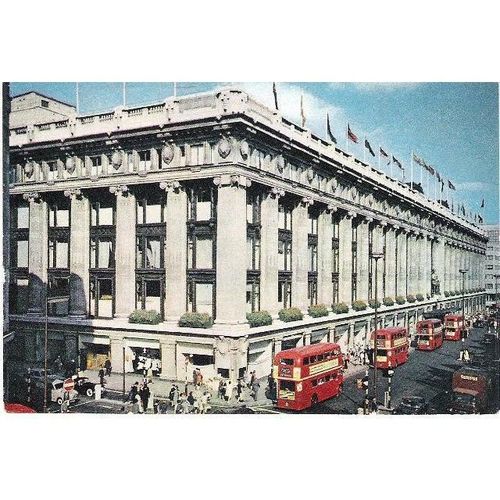

 for 1 item(s)
for 1 item(s)










